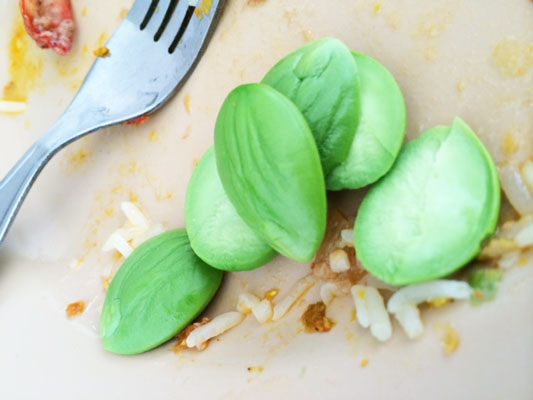When people ask me what ingredient I have the most problem with in Thailand, it’s not the congealed pig blood, boiled pork intestines, fermented shrimp paste or even the deep-fried bugs.
After all, most Bangkokians don’t really encounter those on a regular basis.
No, it’s those little green stinkers known for perfuming pee and fueling smelly farts: sataw, known as the “bitter bean” or more evocatively, the “stink bean.”
Here’s the thing if you didn’t get it before: They are bitter. In fact, they can be really, really bitter.
They are the grumpy old guys on your plate, the ones there to remind you that not everything in life is sunshine and unicorns and Taylor Swift, a world where pee sometimes smells and your dog isn’t around to blame all your farts on. Frequently pickled, sataw can also be sold still in their pods, which are long and propeller-like and can hold up to 15 “beans” per pod. These beans – which are actually the seeds of the petai tree – grow roughly to the size of a 5-baht coin.
These little guys are frequently sold by the side of the road in southern Thailand, where they are primarily grown and consumed as part of a sataw-enjoying culture that spreads down through Malaysia into Indonesia. Although their bitter taste makes their substitution for baby eggplant in something like a green curry a no-brainer (however ill-advised), sataw are actually more widely enjoyed stir-fried, or even served fresh alongside a deliciously fishy nam prik (chili dip).

Nam prik goong sieb (grilled shrimp chili dip), a Phuket specialty that goes well with sataw. Photo: Phuket City
The thing about the stink bean is that its sulfurous, prickly tang goes so incredibly well with the undercover funk of fresh seafood. It makes little sense that two strong personalities would go so well with each other, but there you have it: sataw stir-fried with fresh sea prawns and hefty dollops of gapi (shrimp paste), or strewn willy-nilly into a red chili sambal, or served fresh in their pods alongside a roasted shrimp or shrimp paste chili dip. All are equally delicious if done right (unapologetically strong, with grand hits of heat) and mesh together in a way that seems completely unorchestrated.
So rush out and enjoy some sataw today, and revel in the way they set off the most offensive and smelliest seafood ingredients you can think of. See how their sharpness form part of the flavor kaleidoscope that makes up Thai food, and how that bitterness serves as a way of reminding you that not everything in life is a downhill walk in the sunlight with your favorite Cabbage Patch doll. And make sure that your dining companion eats as much stink bean as you do, so that you are not the only smelly person in the car on the ride home.
Thai Food 101:
Catching the tail end of the summertime rice festival
Dr. Stinkfruit or: How to Stop Worrying and Love Durian
How to Yum: Make a tasty salad with whatever you got
Nam Prik 101: Is Thailand losing its pungent, chili paste heritage?
The Other Starch: Kanom jeen is the answer to rice burnout





Reader Interactions